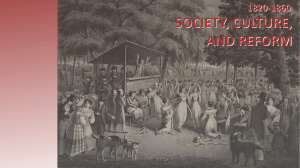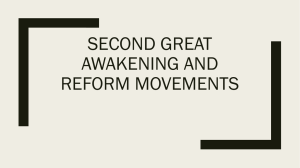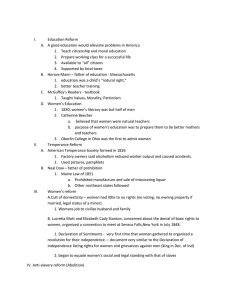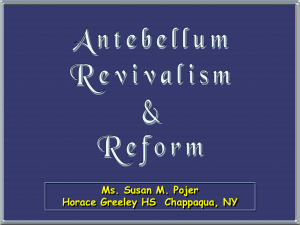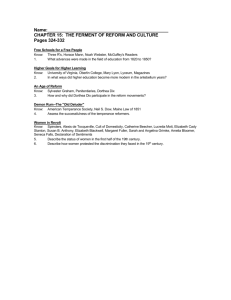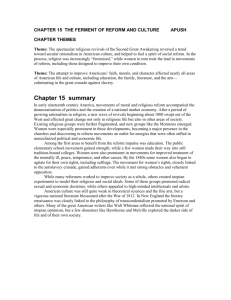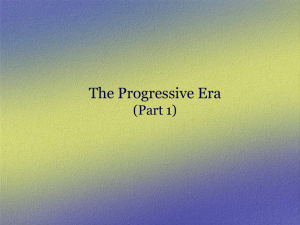Society, Culture, and Reform - Greenwood School District 50
advertisement
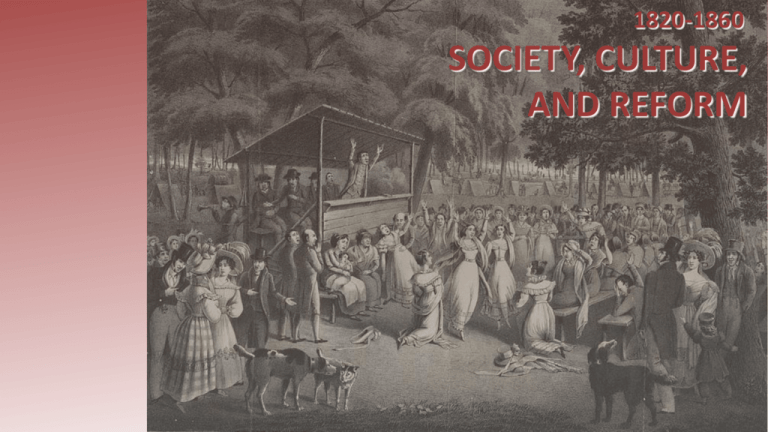
1820-1860 SOCIETY, CULTURE, AND REFORM Essential Question • Evaluate the extent to which reform movements in the United States from 1820-1860 contributed to maintaining continuity as well as fostering change in American society. Religion: The 2nd Great Awakening • Causes: – Reaction to: • Rationalism/Enlightenment ideals • Materialism of Market Revolution • Rejection of Puritan foundations – Western expansion – Perceived “godlessness” • Characteristics: – – – – Camp meetings/revivals Grass-roots organization Individual salvation Democratic, egalitarian Revivalism Expands • The “Burned Over District” – New York • • Charles G. Finney Expansion of Denominations – Baptists and Methodists • Offshoots: – Millennialism/Millerites • 7th Day Adventists – The Mormons • • Joseph Smith, Brigham Young NY OH MO Nauvoo SLC • Transcendentalism – Characteristics: • Challenged materialism • Mystical and intuitive selfdiscovery – Examples: • Emerson – Reject European traditions; Spiritual over material; abolitionist • Thoreau – “On Civil Disobedience,” and Walden • Margaret Fuller American Culture • Utopian Experiments – Brook Farm – The Shakers – New Harmony – Oneida – Fourier Phalanxes • Arts and Literature – Painting • Hudson River School – Cole and Church – Architecture • Greek revival – Literature • Irving, Cooper, Hawthorne, Melville – Performance • Minstrel shows Reforming Society • Temperance – Causes: • • • • – Organizations and Methods • • • American Temperance Society Neal Dow and the Maine Law Penal Reform – – Punishment vs. Rehabilitation Mental Hospitals – Auburn vs. Pennsylvania System • • Overconsumption/alcoholism (5 gal/person) Domestic violence Absenteeism/loss of jobs Nativism Dorthea Dix Educational Reform – Public Schools & Teacher Training • – Moral Education • – Horace Mann McGuffey Readers Higher Education • • Denominational colleges in the west. College education for women: Mount Holyoke & Oberlin Changing Role of Women and Families • Gender Roles: – Cult of Domesticity • Strengthened by men’s absence – Women in the Workplace • Effects on marriage and children – Conformity/Dress • Amelia Bloomer • Movement for Women’s Rights – Grimké Sisters, Lucretia Mott, Elizabeth Cady Stanton • Connection to abolitionist movement – Rejection at World Anti-Slavery Society, 1839 – Seneca Falls Convention (1848) • Declaration of Sentiments Antislavery Movement • • American Colonization Society (1817) American Antislavery Society (1831) – William Lloyd Garrison • • • The Liberator Liberty Party (1840) Abolitionists – Immediatists vs. Gradualists – Arthur & Lewis Tappan – Black Abolitionists • Frederick Douglass – • The North Star Walker, Tubman, Truth – Rebellions • • Denmark Vesey (1822) Nat Turner (1831) – Underground Railroad Reaction and Legacy • Sectionalism: – Southerners viewed northern reforms as alarming • Threats to: – – Slavery Way of life – In the North, advances in transportation allowed for widespread influence of both religious and secular movements – Western expansion created both social and economic conflict • Legacy: – Birth of “American” culture and ideals • Religion, education, arts, and entertainment – Widespread reform movements both united and divided the country.
